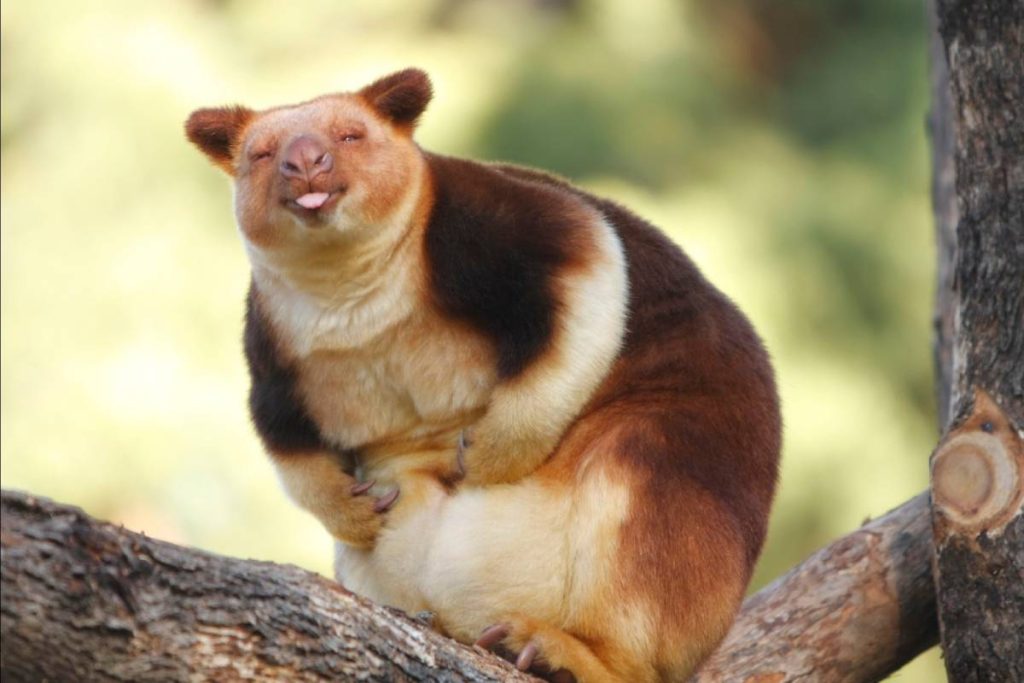Why is it called a tree kangaroo? How rare is the tree kangaroo? What is the closest relative to the tree kangaroo? Click here for more
Welcome to the intriguing world of tree kangaroos, where the ordinary transforms into the extraordinary. These remarkable marsupials, known for their arboreal escapades, have captured our curiosity.
In this article, we will talk about why is it called a tree kangaroo, how rare is it, and who is the closest relative to the tree kangaroo. Join us on a journey through the treetops as we delve into the captivating stories of these unique creatures.
Why is it called a tree kangaroo?
The term “tree kangaroo” might spark curiosity and images of kangaroos swinging from branches like acrobats in the treetops. While this mental image isn’t far off, the reality of tree kangaroos is equally fascinating. Let’s dive into the world of these unique marsupials and explore why they earned the peculiar name.
Tree-kangaroos are a distinct subgroup within the kangaroo family, known for their remarkable adaptation to life in the trees. Unlike their ground-dwelling relatives, tree kangaroos have evolved specialized features that enable them to navigate and thrive in the canopy of forests. The name “tree kangaroo” succinctly captures their dual affinity for both trees and their kangaroo lineage.
One of the key reasons for their arboreal lifestyle is the environment they inhabit. Tree kangaroos primarily reside in the lush rainforests of Australia and Papua New Guinea, where dense vegetation and tall trees create an ideal habitat for these agile creatures. Their unique anatomy, which includes longer and stronger limbs, allows them to leap and move with agility through the branches.

The tail of a tree kangaroo plays a crucial role in maintaining balance while navigating the treetops. Unlike the thick, muscular tails of their ground-dwelling relatives, tree kangaroo tails are long and muscular, serving as a counterbalance to their body weight as they traverse the elevated terrain. This adaptation enhances their stability on precarious branches, preventing accidental falls.
Another notable feature distinguishing tree kangaroos is their elongated claws. These sharp claws are essential for gripping onto branches and tree trunks securely. The ability to cling to different surfaces enables them to access various parts of the forest canopy in search of food, such as leaves, fruits, and flowers. Their diet primarily consists of plant matter, reflecting their adaptation to the abundance of vegetation in their arboreal homes.
The reproductive habits of tree kangaroos are consistent with their marsupial relatives. Female tree kangaroos have pouches in which they carry and nurture their underdeveloped young. This pouch serves as a safe haven during the vulnerable early stages of their offspring’s life. The adaptability of marsupials, including tree-kangaroos, showcases the diversity of reproductive strategies within the animal kingdom.
The conservation status of tree kangaroos highlights the importance of understanding and appreciating these unique creatures. Habitat loss and human activities pose significant threats to their survival. Conservation efforts are underway to protect their natural habitats and raise awareness about the importance of preserving the biodiversity of the regions they inhabit.
How rare is the tree kangaroo?
The tree kangaroo, with its charming name and unique lifestyle, holds a special place in the world of wildlife. When it comes to rarity, these fascinating creatures are indeed considered relatively uncommon compared to their more terrestrial kangaroo cousins. Let’s explore just how rare the tree-kangaroo is and what factors contribute to its distinctive status.
Tree kangaroos belong to a select group within the kangaroo family, and they are not as widely distributed as their ground-dwelling relatives. Their primary habitats are the dense rainforests of Australia and Papua New Guinea. The specific requirements of their environment, including tall trees and abundant vegetation, make their preferred living spaces somewhat limited.
The specific species of tree kangaroo also plays a role in their rarity. There are several species within the tree-kangaroo group, each with its own unique characteristics and distribution. For example, the Matschie’s tree-kangaroo, native to Papua New Guinea, is one of the most well-known species. However, even within its limited range, the Matschie’s tree-kangaroo faces threats to its population due to habitat loss and hunting.

Habitat loss is a significant factor contributing to the rarity of tree kangaroos. Human activities, including logging, agriculture, and urbanization, have led to the fragmentation and destruction of their natural habitats. As these habitats shrink, the populations of tree kangaroos become isolated, making it challenging for them to find suitable mates and maintain genetic diversity. Conservation efforts are crucial in mitigating the impact of habitat loss and ensuring the survival of these unique marsupials.
In addition to habitat loss, hunting poses a threat to some tree-kangaroo populations. While cultural practices and subsistence hunting have historically played a role in the lives of local communities, unsustainable hunting practices can lead to declines in tree-kangaroo populations. Conservation initiatives often involve working collaboratively with local communities to promote sustainable practices and protect these remarkable animals.
Conservation status assessments vary for different species of tree kangaroos, but many are listed as vulnerable or endangered. This emphasizes the urgency of conservation efforts to address the factors contributing to their rarity. Conservation initiatives typically include habitat protection, community engagement, and research to better understand the ecology and behaviour of tree kangaroos.
What is the closest relative to the tree kangaroo?
The tree kangaroo, with its enchanting name and distinctive features, belongs to a fascinating family tree within the marsupial world. To uncover its closest relatives, we need to delve into the realm of macropods, the family that encompasses kangaroos, wallabies, and, of course, our aerial acrobats—the tree kangaroos.
In the grand family of macropods, tree kangaroos are closely related to their more well-known terrestrial counterparts, such as the kangaroo and the wallaby. The term “macropod” actually means “big foot,” aptly describing the large hind limbs that these marsupials use for hopping and bouncing.
Within the macropod family, tree kangaroos belong to the genus Dendrolagus, a group that includes several species known for their arboreal (tree-dwelling) lifestyles. While their terrestrial relatives are known for their powerful legs and impressive hopping abilities, tree kangaroos have evolved unique adaptations for life in the trees.
One of the closest relatives to the tree kangaroo is the Goodfellow’s tree kangaroo, scientifically known as Dendrolagus Goodfellow. This species is native to the rainforests of Papua New Guinea and shares a common ancestry with other tree kangaroo species. Goodfellow’s tree-kangaroo, like its relatives, has distinctive features such as longer and stronger limbs, a muscular tail for balance, and sharp claws for gripping onto branches—all adaptations that make them well-suited for an arboreal lifestyle.

Despite their similarities, it’s important to note that the various species of tree kangaroos within the genus Dendrolagus can have unique characteristics and inhabit different regions. Each species has adapted to the specific challenges and opportunities presented by its particular environment.
On a broader scale, all macropods, including both ground-dwelling and tree-dwelling species, are members of the marsupial family. Marsupials are characterized by their reproductive method, where females carry and nurse their undeveloped young in a pouch. This distinctive feature sets marsupials apart from other mammals.
The evolutionary journey of tree kangaroos within the macropod family showcases the incredible adaptability of marsupials to diverse habitats. While their terrestrial relatives have mastered the art of hopping across vast landscapes, tree kangaroos have taken to the trees, demonstrating the versatility and resilience of these marsupials.
In summary, the closest relatives to the tree kangaroo are the other members of the macropod family, including kangaroos and wallabies. Within this family, the genus Dendrolagus specifically encompasses the tree-dwelling species, with Goodfellow’s tree-kangaroo being one of the notable members. Appreciating the diversity within the macropod family allows us to marvel at the unique adaptations that have evolved, shaping these marsupials into the remarkable creatures they are today.
Conclusion
In the lush rainforests of Australia and Papua New Guinea, tree kangaroos swing gracefully through the branches, leaving an indelible mark on the tapestry of biodiversity. As we reflect on why they’re called “tree-kangaroos,” it becomes clear that their name encapsulates the essence of kangaroos that have taken to the trees.
Their rarity, a result of habitat loss and human impact, calls for our attention and conservation efforts. Delving into the family tree, we find their closest relatives among the macropods, showcasing the diverse adaptations within the marsupial world.
In preserving the habitats of these extraordinary creatures, we contribute to the symphony of life in our planet’s vast and interconnected ecosystems.





